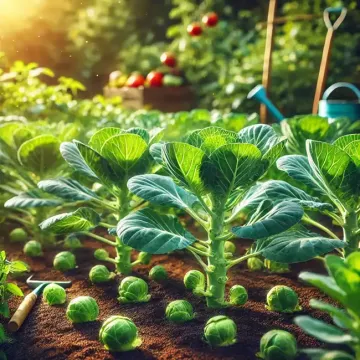Brussels sprouts, a member of the Brassica family, are cool-season vegetables prized for their unique flavor and nutritional benefits. Despite their reputation for being difficult to grow, with the right care, they can thrive in home gardens. Brussels sprouts are often associated with colder climates and require a long growing season, making them an excellent choice for gardeners looking to extend their harvest into the fall and winter.
History and Background
Brussels sprouts are believed to have originated in the Mediterranean region, but they became widely cultivated in Belgium, specifically around Brussels, which is how they got their name. They have been a staple in European kitchens for centuries, especially in the colder northern regions where the climate is ideal for growing these hardy vegetables.
Health Benefits
Brussels sprouts are a nutritional powerhouse. They are rich in vitamins C and K, fiber, and antioxidants. Regular consumption of Brussels sprouts may support immune function, improve digestion, and reduce inflammation. They are also low in calories and offer a range of micronutrients like folate, manganese, and potassium.
Growing Conditions
Brussels sprouts thrive in cool weather, ideally between 45°F and 75°F (7°C to 24°C). They require a long growing season of around 85 to 100 days from transplanting to harvest, making them best suited for spring or fall planting. In warmer climates, they are typically planted in late summer for a fall or early winter harvest.
- Soil Requirements: Brussels sprouts prefer well-drained, fertile soil with a pH between 6.0 and 6.8. Adding organic matter, such as compost, can improve soil structure and fertility. A soil test can help determine if any amendments are needed.
- Light: These plants need full sun, at least 6 hours of direct sunlight per day, to produce the best yields. Insufficient light can result in leggy plants and smaller, less flavorful sprouts.
- Watering: Consistent moisture is critical for Brussels sprouts. The soil should be kept evenly moist but not waterlogged. Mulching around the plants helps retain moisture and regulate soil temperature.
- Spacing: Space plants about 18 to 24 inches apart in rows that are 30 inches apart. This spacing allows for good air circulation, which helps prevent disease.
Planting and Care
Brussels sprouts are usually started from transplants rather than seeds because of their long growing season. However, if you start from seed, sow them indoors 6 to 8 weeks before the last expected frost date.
- Transplanting: Transplant seedlings into the garden when they are 4 to 6 weeks old and have at least two sets of true leaves. Harden off the seedlings before planting them in the garden by gradually exposing them to outdoor conditions.
- Fertilizing: Brussels sprouts are heavy feeders. Apply a balanced fertilizer at planting and again halfway through the growing season. Side-dressing with compost or organic fertilizer can provide additional nutrients as the plants grow.
- Pest and Disease Management: Common pests include aphids, cabbage worms, and flea beetles. Using floating row covers or practicing crop rotation can help minimize pest problems. Diseases such as clubroot, downy mildew, and black rot can be avoided by proper spacing, avoiding overhead watering, and using disease-resistant varieties when available.
- Staking and Support: Brussels sprouts can grow tall, often reaching heights of 2 to 3 feet. Staking the plants can help support them, especially in windy conditions or if they are heavily loaded with sprouts.
Harvesting
Brussels sprouts are harvested when the small, cabbage-like buds on the plant's stem are firm and about 1 to 2 inches in diameter. Harvest sprouts from the bottom of the stalk upward as they mature. The plant will continue to produce sprouts as long as the weather stays cool. Frost can enhance their flavor by converting starches into sugars, making the sprouts taste sweeter.
Culinary Uses
Brussels sprouts can be prepared in various ways—roasted, steamed, sautéed, or even grilled. They pair well with robust flavors such as garlic, balsamic vinegar, bacon, or nuts. Roasting Brussels sprouts with olive oil and seasoning brings out a rich, caramelized flavor that many people find delicious.
Conclusion
Growing Brussels sprouts can be a rewarding experience for the home gardener. With proper care, these cold-hardy plants can provide a bountiful harvest of nutritious, flavorful sprouts. Whether you're a fan of the traditional boiled version or prefer them crispy and roasted, fresh Brussels sprouts from your garden are sure to enhance your meals throughout the fall and winter months.

